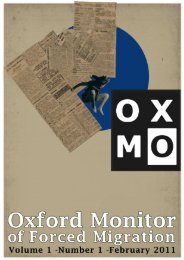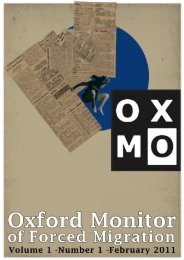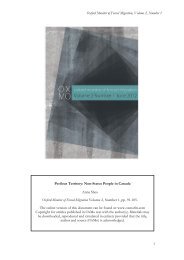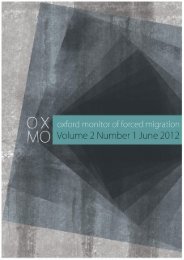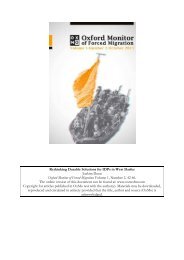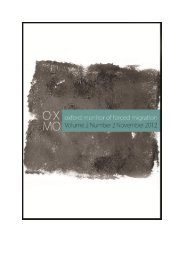Oxford Monitor of Forced Migration, Volume 3, Number 1
Oxford Monitor of Forced Migration, Volume 3, Number 1
Oxford Monitor of Forced Migration, Volume 3, Number 1
Create successful ePaper yourself
Turn your PDF publications into a flip-book with our unique Google optimized e-Paper software.
<strong>Oxford</strong> <strong>Monitor</strong> <strong>of</strong> <strong>Forced</strong> <strong>Migration</strong> Vol. 3, No. 1Development in Burma Proper integrated lowland Burman society into a homogenised core.This was evidenced by the rapid erosion <strong>of</strong> Mon identity, culture and language in SouthernBurma under direct British rule. In contrast, the Frontier Areas were indirectly administeredby the British in ways which ossified pre-colonial socio-political structures where power wasretained by chieftains and social participation confined to specific ethno-linguistic locales(South 2008). Thant (2001) notes how old court notions <strong>of</strong> a mandala-periphery fused withEuropean linguistics to ensure that, as South (2008: 10) also concludes: ‘the separateidentities <strong>of</strong> Bama [Burman] and non-Burmans were reinforced by the colonial experience’.Blood and GodThe ossification <strong>of</strong> the Frontier Areas into heterogeneous ethno-linguistic blocs highlights theongoing significance <strong>of</strong> shared historical memory in the manufacture <strong>of</strong> ethno-nationalistidentity. The Frontier Areas during the colonial era would serve as incubators for a pan-Karen identity constructed in opposition to the Burman core and, partially, by appeal to theoral histories <strong>of</strong> the Karen people. Hill-tribes on the periphery <strong>of</strong> pre-colonial lowlandmandala centres <strong>of</strong> power had been marginalised and exploited: animist Karen song-poems,hta, reference forced labour and massacre at the hands <strong>of</strong> Buddhist Burman overlords (Min2000) and, earlier in history, violent expulsion from the Irrawaddy delta (San 1928). TheFrontier Areas’ isolation from Burma’s modernising, ‘cosmopolitan’ core certainlycontributed to the emergence <strong>of</strong> a shared history amongst the Karen. But it was the Burmanassociation <strong>of</strong> the Karen with both imperialism and Christianity that would see the reemergenceand reinforcing <strong>of</strong> the inter-ethnic tensions precipitating Karen displacement.After 1828, the growth <strong>of</strong> Christianity amongst a fraction <strong>of</strong> S’Gaw Karen contributed to theperception that the Karen as a whole were committed to the destruction <strong>of</strong> Buddhist-Burmancivilisation. In reality, various Karen sub-groups had previously engaged in both anticolonialistand pro-British armed struggle (South 2008). Upon complete annexation in 1886,the British actively recruited Burma’s ethnic minorities into its armies. In 1925, they adoptedan exclusively non-Burman recruitment policy in which Karen were particularly favoured; by1937 they made up 25% <strong>of</strong> the Burma Military Police, half <strong>of</strong> the Burma Rifles andoutnumbered Burmans three to one in the British India Army. This bolstered Burmanperceptions <strong>of</strong> Karen as colonial proxies, particularly when, as in the Saya San rebellion <strong>of</strong>1930 to 1931, Karen troops were used to crush Burman resistance.For Burma, colonial rule was traumatic. Upon completion <strong>of</strong> the British conquest in 1885, thepolitical and cultural nexus <strong>of</strong> the Burman people, Mandalay Palace, was desecrated and theirconceptual system - based largely on the harmony between religious and political authorityunderlying Buddhist cosmology - was shattered (Gravers 1999). Further erasure <strong>of</strong> theBrahmanic political culture met fierce and popular resistance leading to two years <strong>of</strong> Britishcounter-insurgency (Thant 2001). Burmans viewed Christianity as a perniciousfundamentalism determined to uproot the cosmological and ontological foundations <strong>of</strong> adhamma ordered universe. Elements <strong>of</strong> religious war emerged as Christian Karen were pittedagainst Buddhist Burman during colonisation (Gravers 1993). This recurred during WWIIunder respective British and Japanese alliances. Many disenfranchised S’gaw Karen,meanwhile, perceived the British as liberators. Positive relations with the Empire werelubricated by a growing number <strong>of</strong> American Baptist Karen elites who established the KarenNational Association: which was the precursor <strong>of</strong> the KNU. Thus, from the outset, a brand <strong>of</strong>Christianity was critical in the establishment <strong>of</strong> an ethno-nationalist, modern sense <strong>of</strong> ‘pan-69



